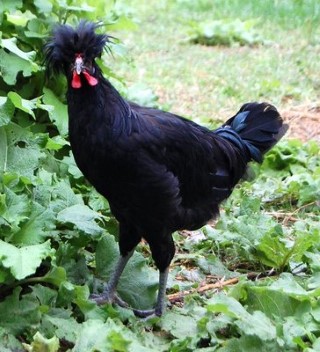Crevecoeur chickens are a dual-purpose bird; but they serve
mainly as an ornamental show bird today. They do, however, lay 120 medium eggs
per annum and matures into a meaty fowl in a reasonable amount of time.
Crevecoeur chickens boast a short grained, extremely white meat on small boned
skeleton. They have a high percentage of meat to total carcass weight.
The American Livestock Breeds Conservancy has listed the
Crevecoeur as endangered worldwide. The US has less than 500 Crevecoeur breeding
chickens.
Although described as an active breed, Crevecouers bear
confinement well and rarely go broody in the coop. Owners characterize them as
calm, friendly, and easy to handle. However, some Crevecoeur breeders report
that certain individuals have an aggressive side. Crevecoeurs like to move but
rarely forage in spite of their constant activity. Quiet, deliberate, and not
prone to flightiness, Crevecoeurs do well in a backyard setting.
Crevecouer roosters weigh around eight pounds and the hen’s
weigh around seven. The bantams run around two pounds. Crevecoeurs have a
lordly appearance in their full black crest with matching beard and muffs.
Their plumage, jet black with a greenish tint, distinguishes them on the
exhibition floor. Crevecoeurs have red V comb that looks like horns on the
rooster. The hen conceals her smaller V comb with her crest. Both rooster and
hen have small red wattles and earlobes. Their black beak with shades of horn
color at the tip produces a stately but somewhat menacing appearance.
Crevecoeurs support themselves on gun blue legs not favored in American meat
markets but suitably matched to their striking plumage. In many ways Crevecoeurs
resembles Houdan chickens except they have four toes in contrast to the five
toed Houdan.
Keep your Crevecoeurs warm. Frostbite easily occurs on the
vulnerable crests and V combs of Crevecoeurs. Build a dry, draft-free coop. Crevecoeurs
have little tolerance to cold, rain, and wind. Many owners report lackluster
egg production for the breed; however, others report a consistent egg per day.
Feed a good layer food and supplement with extra protein and calcium for better
egg production. Artificial lighting added to the morning hours always helps as
the days get shorter. Run your Crevecoeurs on wood shavings to protect their
show plumage from dust and damage. Move the run occasionally to prevent the buildup
of parasites in the soil.
